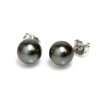Pearls are very popular with the general public. Genuine pearls are often well installed in the windows of jewelry stores, even on the internet. If one often comes across sites selling real pearls online, it is also quite likely to arrive on imitation pearl sites with the real pearl stamp. We are then entitled to ask ourselves the question: how to recognize a pearl of culture?
Fancy pearls
Fancy pearls are the first to appear. Indeed, in 1600, a certain Jaquin had the good idea to realize oriental essence to make fancy pearls. The oriental essence is based on fish scales, dissolved in a solvent.
He used glass, which he turned into a small hollow ball by blowing. Then, through a small hole, he filled it with the essence of the orient that recalled the mother-of-pearl aspect of the oriental pearls. The culture pearls imitation was almost perfect. The only negative was that the pearls broke and slipped under the teeth.
At the time, to check that a pearl was real, it was put between the teeth. If it slipped, it was glass and therefore a false cultured pearl and if it hung the teeth, then it was a real pearl. But with today's progress, imitation goes even further, perfectly mimicking this rock effect under the tooth.
Imitation pearls
Imitation pearls are artificial, made of ceramic, glass or even plastic. A varnish coats them to get as close as possible to the brilliance of a real cultured pearl. Of course, selling this type of pearl under the real pearl stamp is a fraud, like all the fake pearls we're going to talk about in this article.
Imitation pearls don't break as easily as they used to, but they flake very quickly.
Nowadays, imitation can be perfectly achieved, especially with the pearls of Mallorca, where it is now possible to reproduce the manufacturing process with machines, as what the oyster does naturally. Shell pearls or shell pearls are imitation pearls made in China.

How to recognize a cultured pearl
First, real Tahitian pearls are expensive. So if you come across a few of them on a cheap adornment or other, beware, pearls are surely imitations. In relation to the price, you should know that it is a guarantee of quality. Indeed, it takes 4 years for an oyster to make a pearl and on a hundred pearls, only 25 can be sold and 5 will be classified as A (low quality).
Apart from the price, you have to look for imperfections. Indeed, there must be some. The rounder beads are rare, so if you see a necklace with beautiful flawless round beads, it's surely imitation. Tahitian cultured pearls are very rarely round. They are more often oval, in the form of water drops or baroque style, as if they had had a strap during their manufacture. In this way, even the most expensive Tahitian pearl necklaces are never perfect. They always have flaws.
The real tahitian cultured pearls have a perfect glow and reflect the light. So you have to be able to see your reflection.
As for color, true cultured pearls never have a solid color, they always have shades of color on the surface. Also, if you find pearls with colors that are out of the ordinary like pink, purple or blue, then they are not authentic.
Indeed, these are stones that will have undergone a treatment to change color. Also, the real stones are always cold (as long as they have not been laid or manipulated). You place the pearls in your hand to estimate their temperature. Conversely, a fake plastic pearls will already be at room temperature.

Conclusion
To conclude, it is very easy to be signed when you are not used to having pearls in your hands. However, remember that a real pearl also has its flaws and that it is impossible to demand perfection. If you are looking for real cultured pearls, you will easily find them on the PearlAndGold Pearls website.


















